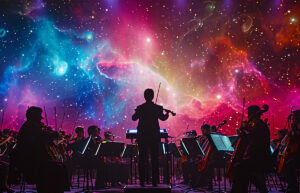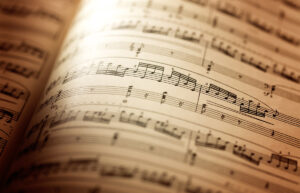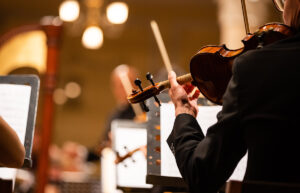What is a Music Genre? Meaning, Elements & Popular Music Genres

Music is a universal language expressing and evoking various emotions, thoughts, and experiences. Music can also be a diverse and complex art form that can be categorized and classified differently. One of the most common and valuable ways to understand and appreciate music is by its genre. But what is a music genre? And how can we identify and differentiate the various types of music genres?
In this guide, we will delve into the concept of the music genre and the origins, evolution, and characteristics of some of the world’s most popular and influential music genres.
Welcome to TheDemoStop, now join the community!
Connect with artists, fans and producers around the world.
What is a music genre?
A music genre groups pieces of music with common characteristics, such as style, form, or origin. Different music genres have different rules and conventions that shape the music sounds and the instruments used. For example, rock music typically features electric guitars, drums, and vocals, while classical music usually involves orchestral instruments, complex structures, and melodies.
History of music genres (Origin & Evolution)
Genre is a French word that means “kind” or “type.” It was first used in English in 1770 to refer to a “particular style of art,” especially in painting. Later, it was applied to other forms of artistic, musical, or literary expression that share common characteristics, forms, or content.
Music genres are not fixed or objective but evolve over time and across regions as new musical trends emerge and old ones fade or transform. Music genres are also influenced by social, political, and technological factors that shape the production and consumption of music. Presently, we have an array of music genres, ranging from classical and jazz to rock, pop, hip-hop, electronic dance music (EDM), and many more.
Elements of music genres
Sound
What is a music genre element that is the most important? It’s sound. It refers to the quality and tone of the music, such as loud, soft, bright, dark, clear, or distorted. Sound is influenced by the timbre, pitch, volume, and dynamics of the music, as well as the effects and processing applied to it. For example, rock music typically has a loud and distorted sound, while classical music usually has a clear and pure sound.
Rhythm
This part refers to the pattern and tempo of the music, such as fast, slow, steady, or irregular. Rhythm is influenced by the meter, beat, accent, and syncopation of the music, as well as the genre-specific conventions and variations. For example, jazz music often has a complex and syncopated rhythm, while pop music usually has a simple and steady rhythm.
Melody
This element refers to the main tune or theme of the music, such as high, low, ascending, descending, or varied. Melody is influenced by the scale, mode, key, and interval of the music, as well as the genre-specific motifs and expressions. For example, folk music often has a simple and catchy melody, while metal music usually has a fast and aggressive melody.
Harmony
This piece refers to the combination and relationship of the different notes and chords of the music, such as consonant, dissonant, major, minor, or modal. Harmony is influenced by the chord progression, tonality, and modulation of the music, as well as the genre-specific rules and techniques. For example, country music often has a simple and diatonic harmony, while jazz music usually has a complex and chromatic harmony.
Lyrics
This segment refers to the words and meaning of the music, such as literal, figurative, poetic, or narrative. Lyrics are influenced by the language, style, and message of the music, as well as the genre-specific themes and topics. For example, rap music often has fast and rhythmic lyrics, while opera music usually has slow and dramatic lyrics.
Instruments
This detail refers to the tools and devices used to produce the sound of the music, such as acoustic, electric, or electronic. Instruments are influenced by the availability, technology, and innovation of the music, as well as genre-specific preferences and traditions. For example, reggae music often uses drums, bass, guitar, and organ, while EDM music usually uses synthesizers, samplers, and computers.
Composition
The question “What is a music genre?” is often answered by looking at the composition of the music. Composition refers to the structure and arrangement of the music, such as simple, complex, linear, or circular. Composition is influenced by the form, genre, and purpose of the music, as well as the genre-specific patterns and elements. For example, classical music often has a complex and symmetrical composition, while rock music usually has a simple verse-chorus composition.
Ten popular music genres
Pop music
When talking about what is a music genre, one simply cannot move forward without mentioning pop music first. Pop music is any popular and mainstream music in a certain period. Pop music can incorporate elements from various genres, such as rock, dance, folk, and hip-hop. Pop music is usually catchy, upbeat, simple, and appeals to a wide audience. Some of the most influential pop artists include Michael Jackson, Madonna, Taylor Swift, and Beyoncé.
Hip-hop and rap
Hip-hop and rap are influenced by funk, disco, reggae, and rock and use sampling, scratching, and beatboxing. Hip-hop and rap express the culture and issues of the urban communities, as well as the creativity and innovation of the artists. Some famous hip-hop and rap artists include Dr. Dre, Tupac, Biggie Smalls, Eminem, and Kendrick Lamar.
Rock music
Rock music is characterized by electric guitars, drums, and vocals that express the spirit of youth and rebellion. Rock music evolved through several phases, including the British Invasion, psychedelic, punk, heavy metal, alternative, and indie rock. Some legendary rock bands include The Rolling Stones, The Beatles, Led Zeppelin, Pink Floyd, and Nirvana.
Welcome to TheDemoStop, now join the community!
Connect with artists, fans and producers around the world.
Dance and electronic music
Dance and electronic music use electronic instruments, such as synthesizers, samplers, and computers, to create sounds and rhythms. Dance and electronic music are often played in clubs, raves, and festivals. Dance and electronic music have many sub-genres, such as house, techno, trance, dubstep, and EDM. Some popular dance and electronic music artists include Daft Punk, Calvin Harris, Skrillex, and David Guetta.
Latin music
Latin music is influenced by indigenous, African, European, and American music and features instruments such as guitars, percussion, brass, and keyboards. Latin music has many sub-genres, such as salsa, merengue, bachata, reggaeton, and Latin pop. Latin music is known for its lively, passionate, rhythmic qualities, cultural diversity, and richness. Some of the most famous Latin music artists include Celia Cruz, Carlos Santana, Shakira, and Luis Fonsi.
Country music
Country music is folk music that narrates the lives and stories of rural Americans. Country music is backed by Celtic, gospel, and blues and uses instruments such as the guitar, banjo, fiddle, and harmonica. Country music evolved through various sub-genres, such as honky-tonk, bluegrass, country rock, outlaw country, and country pop. Iconic country music artists include Johnny Cash, Dolly Parton, and Willie Nelson.
Metal
Metal is an extreme form of rock music characterized by distorted guitars, fast drums, loud vocals, and dark themes. Metal has many sub-genres, such as thrash, death, black, and power metal. Metal is known for its intensity, aggression, complexity, and loyal and dedicated fan base. Some of the most influential metal bands include Black Sabbath, Metallica, Slayer, and Iron Maiden.
Classical music
Classical music is usually composed and performed by trained musicians and follows strict rules and structures. It is divided into several periods, such as the Baroque, Romantic, and Modern periods. Some of the most renowned classical music composers include Bach, Mozart, Beethoven, and Chopin.
Reggae
Inspired by ska, rocksteady, rhythm and blues, and African music, reggae features instruments such as drums, bass, guitar, and organ. Reggae is known for its offbeat rhythms, relaxed tempo, and social and political messages. Some legendary reggae artists include Bob Marley, Peter Tosh, Jimmy Cliff, and Burning Spear.
Jazz
Jazz is influenced by blues, ragtime, and marching band music and features improvisation, complex rhythms, and syncopation. Jazz went through various stages, such as swing, bebop, cool jazz, hard bop, modal jazz, free jazz, and fusion. Some famous jazz musicians include Louis Armstrong, Duke Ellington, Charlie Parker, and Miles Davis.
Example songs of different music genres
“Drop It Like It’s Hot”- Hip-Hop
This song is by American rapper Snoop Dogg and features producer and singer Pharrell Williams. It was released in 2004 as the lead single from Snoop Dogg’s seventh studio album, R&G (Rhythm & Gangsta): The Masterpiece.
“Spring” by Antonio Vivaldi- Classical music
This song is the first movement of The Four Seasons, a set of four violin concertos by Italian composer Antonio Vivaldi. It was composed in 1723 and published in 1725 as part of a collection of twelve concertos, Op. 8.
“Sweet Child O’ Mine” by Guns and Roses- Rock music
This song is by American rock band Guns N’ Roses, featuring singer Axl Rose, guitarist Slash, bassist Duff McKagan, drummer Steven Adler, and rhythm guitarist Izzy Stradlin. It was released in 1988 as the third single from their debut studio album, Appetite for Destruction.
“I Walk The Line,” by Johnny Cash- Country music
This song is by American singer-songwriter and musician Johnny Cash. It was released in 1956 as his debut single and the title track from his first studio album, With His Hot and Blue Guitar.
“Beat It” by Michael Jackson- Pop music
This song is by American singer, songwriter, and dancer Michael Jackson. It was released in 1983 as the third single from his sixth studio album, Thriller. The song is a pop music track with a catchy and danceable groove, a synthesizer-driven arrangement, and a guest guitar solo by Eddie Van Halen.
Impact of music genres on the human body
What is a music genre’s effect that creates such a profound impact on us? Let us look at the point below:
- Physical effects: Music can influence the motor system, such as coordination, balance, and movement. For example, rhythmic and dance music can stimulate the motor cortex and enhance physical performance, while classical and ambient music can improve fine motor skills and accuracy.
- Psychological effects: Music can affect the cognitive and emotional processes of the brain, such as memory, attention, learning, and mood. For example, music with clear lyrics can enhance verbal memory and language skills, while instrumental music can improve spatial memory and reasoning.
- Social effects: Music can affect the interpersonal and cultural aspects of human life, such as communication, identity, and belonging. For example, music can facilitate social interaction and bonding, such as singing, dancing, and playing together, as well as expressing and sharing emotions and opinions.
Welcome to TheDemoStop, now join the community!
Connect with artists, fans and producers around the world.
Conclusion
What is a music genre?
A music genre is a specific style or category of music that shares common characteristics and themes.
History of music genres
The history of music genres is complex and diverse, as different genres emerged, evolved, influenced, and interacted with each other over time and across regions.
Elements of music genres
- Sound
- Rhythm
- Melody
- Harmony
- Lyrics
- Instruments
- Composition
Ten popular music genres
- Pop music
- Hip-hop and rap
- Rock music
- Dance and electronic music
- Latin music
- Country music
- Metal
- Classical music
- Reggae
- Jazz
Example songs of different music genres
- Hip-hop: “Drop It Like It’s Hot”
- Classical music: “Spring” by Antonio Vivaldi
- Rock music: “Sweet Child O’ Mine” by Guns and Roses
- Country music: “I Walk The Line” by Johnny Cash
- Pop music: “Beat It” by Michael Jackson
Impact of music genres on the human body
- Physical effects
- Physiological effects
- Social effects
FAQs
What is a music genre?
A music genre categorizes pieces of music based on shared characteristics like style, structure, or origin. Each genre follows its own set of rules and conventions, influencing the sounds and instruments utilized in the music.
How did music genres evolve?
Music genres have evolved through cultural exchanges, societal influences, and technological advancements. Each era and movement contributed to the development of new styles and genres.
What is the history of music genres?
The evolution of music genres is intricate and varied, with various styles emerging, evolving, and influencing each other across different regions and eras.
What are the characteristics of music genres?
- Sound
- Rhythm
- Melody
- Harmony
- Lyrics
- Instruments
- Composition
- Performance
- Cultural context
What is the number one genre of music?
Pop music is widely regarded as one of the most popular music genres, known for its catchy, upbeat, and simplistic nature, appealing to a broad audience.
How many different genres of music are there?
- Pop music
- Hip-hop and rap
- Rock music
- Dance and electronic music
- Latin music
- Country music
- Metal
- Classical music
- Reggae
- Jazz
What are the 3 most popular music genres?
According to a report by the International Federation of the Phonographic Industry (IFPI), the three most popular music genres worldwide in 2022 were pop, rock, and hip-hop/rap.
What is the impact of music genres on the human body?
- Physical effects
- Physiological effects
- Social effects































































